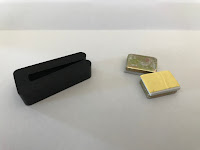The kitchen is often the epicenter for nearly every event that takes place in the home. Its where those special occasions, endless conversations, and unexpected moments, get there start.
Its where secret family recipes and last minute meals always turn out just right. And its where those first hello's, last goodbye's, and late nights finally come to a close.
With kitchens playing such an important role in our every day lives its no wonder that so few repairs and improvements ever get done in this part of the home.
Recently, I had an opportunity to work on one of these active and beloved work spaces, and was tasked with breathing new life into an existing lighting system.
The kitchens lighting had a number of issues going on with it, the first problem was that half of the fluorescent lamps were either flickering or not working at all. The other half offered very little in terms of light and output and were on the verge of going out.
In addition to the failing lighting system there was also this really annoying buzzing sound that seemed to carry through the rest of the house. The homeowners explained that they had had the ballasts replaced multiple times in the past but within a couple of years the buzzing would eventually return.
The other issue with the existing design was that even when the entire system was fully functioning there still wasn't enough light in the kitchen.
Part of the reason for the reduced amount of light was because of the type of diffusers they had. The amber colored diffusers were designed to soften the unappealing fluorescent light that illuminated a given area, but what it actually did was cause the kitchen to take on a dark and dingy look.
After reviewing a number of suggestions with the homeowners the plan was set to revamp the existing system for a more brighter, efficient and buzz free design.
The plan that the homeowners decided to go with was to completely remove the T12 Fluorescent lamps and replace them with *
T8 LED retrofits. Since these specific LED lamps were designed to be direct wired there was no need for any more annoying ballasts.

The next thing we would do was remove the amber colored diffusers and replace those with a clear prismatic option that allowed the light to freely pass and brighten up the space.
To fit within the homeowners time frame and budget they would order the lights and have them overnighted to their home. They would also stop by a local plastics store and have a set of clear prismatic diffusers custom cut to replace the old diffusers.
Once the schedule was worked out, the project began.
Power to the kitchen lights was cut off at the circuit breakers. Next, the old amber diffusers were slid out of place and retired into the recycling bin. Next, all of the fluorescent T12 lamps were removed, carefully bundled, and recycled at a local hardware store.
Quick Note: All fluorescent lamps are hazardous waste and should never be thrown in the garbage bin, they
need to be disposed of properly.
With the T12 lamps now safely out of the way we could continue on with the rest of the project. The next step was to gut the fixtures. To access the wiring and ballasts I located the retainer clip on one end of the cover and gave it a quarter turn.
Sometimes there are two retainer clips or a retainer screw.

All but one of the covers dropped down easily, the other needed a gentle tug before it popped loose.

Taping the retainer clip to the cover so as not to lose it, I then placed the covers aside for later reassembly. With the ballast and wires exposed, I first disconnected the power leads and then moved on to the socket terminal leads.

In most cases the socket terminal leads need to be cut near the ballast, however, these fixtures have had multiple ballast replacements over the years so it wasn't necessary.

Now that the fixtures were completely gutted the rewire process could begin. Using the wiring diagram that came with the T8 LED lamps, each fixture was wired to manufacturer specifications.
Once wiring was completed the cover and retainer clip went back up. I slid the cover in place, inserted the retainer clip into its slot and gave it a quarter turn. The cover was now properly secured in place.

The T8 LED lamps were installed with the LED's facing downward, unlike the fluorescent lamps that can be installed in any direction, the T8 LED's must be installed so that the diodes are pointed in the direction you want to aim the light.
With the new lamps now fully installed all that was left was the prismatic diffusers. I passed all of the newly cut pieces through one of the openings, and then slid each diffuser into place. The kitchen retrofit was now complete.
With the power back
ON, the homeowners were given the honor of being the first to try out the new lights.
They loved it.
Retrofitting an existing lighting design with the latest products can be a big budget saver both for the short term and long term. If your looking to do a lighting project of your own be sure to thoroughly research and plan accordingly.
I hope you've enjoyed this article, if you have any comments, questions or just want to share a similar experience, feel free to leave it below. Until next time. Stay safe.
*LED Model- HLWW420 (3700 Kelvin).
 Now although this required making holes in the door we felt in the long term it would be the better choice.
Now although this required making holes in the door we felt in the long term it would be the better choice.




































